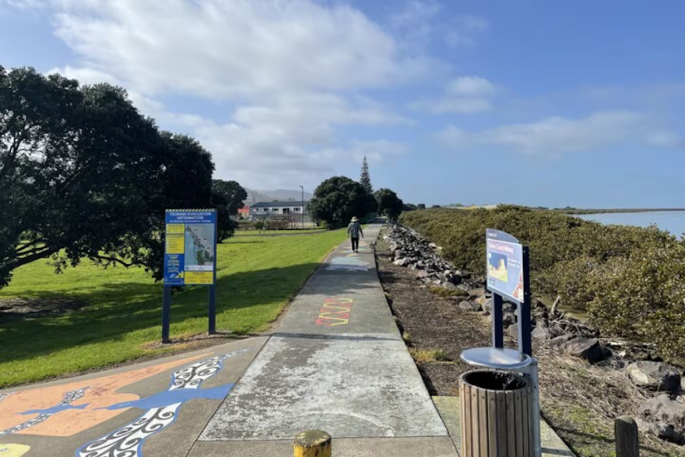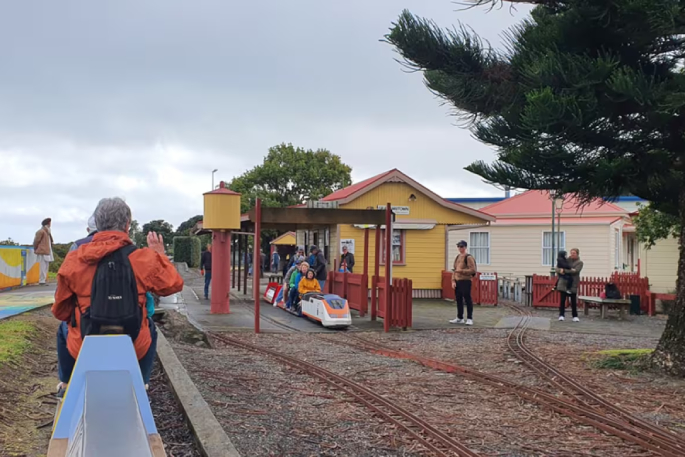A long-standing attraction in Thames is under threat as the proposal to build a seawall to protect the town from flooding and rising sea level moves forward.
The Thames Small Gauge Railway Society was established in 1993 and features a 1km loop track that runs along the Brown St foreshore, with a station, steaming bays, turntable, bridge, tunnel and associated structures.
Thousands of volunteer hours and more than $100,000 was poured into the attraction when it was granted a lease to use the land by the Thames-Coromandel District Council in 1995.
It is situated at Victoria Park and operated by a group of about 30 volunteers.
It sits near the starting point of a proposed seawall as authorities weigh up the options for protecting the town from long-term climate impact.
Shoreline protection has been tagged as a high priority for the town after a management project showed $1 billion in assets in the township are at risk over the long term from hazards associated with sea-level rise.
A public meeting held in June presented various concept designs for protection against a half metre of sea-level rise, and a one-in-100-year storm.
The council’s project governance team then confirmed a stopbank would be constructed where space allows along the Thames foreshore and would generally follow the existing footpath, with an expected height increase of about 1.4 metres.

The design is for a stopbank and an indicative height of 1.4 metres has been suggested, which is what might be expected at Victoria Park where the Thames Small Gauge Railway is situated.
The society has since confirmed it will have to dismantle the site as the seawall is built.
Secretary Russell Skeet said that could cost $170,00-$340,000, depending on two options, and if the council could financially assist them.
Skeet said it would cost about $170,000 just to deconstruct the track and associated buildings and facilities, then move them to a storage facility in nearby Kopu.
It would cost an estimated $340,000 to deconstruct then reassemble and reconfigure the track, associated buildings and facilities on the site.
The Hauraki-Coromandel Post put questions to the council after Skeet confirmed the society had recently met with the council’s project team to discuss the options.
The council was asked to confirm it had been in discussions with the society, what had been proposed, estimated costs, timelines, and potential options, but the council did not address the matter directly.
Seawall project lead Amon Martin did confirm the area of foreshore designated for protection would run from Hape Stream near the Toyota factory to the Victoria Park/Croquet Club, the area occupied by the Thames Small Gauge Railway Society.
“There’s a strong case for central government input given the assets that will benefit from protection, including our state highway; once the design work is finalised, that will allow us to pursue specific and targeted discussions with various agencies on funding options,” Martin said.
“Once likely costs have been determined, options for funding the construction of protection will go to community consultation before any decisions are made.”
Martin confirmed funding sources would likely include a mix of central agency contributions and targeted rates.
“Over the next month we’ll be updating councillors on project progress, to be followed by another public meeting. The meeting will provide an update on our work to understand fluvial, or river, hazards and risks to Thames and how these may impact the project.
“The project team also expects to have more information to share at the meeting on the expected costs associated with construction, which have not yet been confirmed.”

The Thames Small Gauge Railway, with the coastal footpath situated to the left.
Skeet said the society did not see the matter as contentious, as it was understood the council had been proactive in its approach to them.
“It does have implications for us though, as we will have to deconstruct the site, it is a really big deal for us.
“We were pleased the council came and spoke to us, I thought they did a reasonable job at presenting it.”
Skeet said the proposed seawall would have a profound effect on the railway, covering up a significant part of the track.
“If it turned out that we would have to pay for it then the answer would be no, if the council would pay for most of it then it would happen.”
In August Audit New Zealand sounded a warning to Thames-Coromandel District Council over plans to spend $92 million on shoreline protection.
The warning was issued in an audit of the council’s 2024-34 long term plan consultation document, with Audit saying it considered the council’s funding assumption for coastal hazards as “unreasonable”.
Audit said the council had assumed 60% of shoreline protection costs ($55.8m) would be funded by the Government and considered the assumption unreasonable because the Government had not yet agreed to provide funding.



0 comments
Leave a Comment
You must be logged in to make a comment.